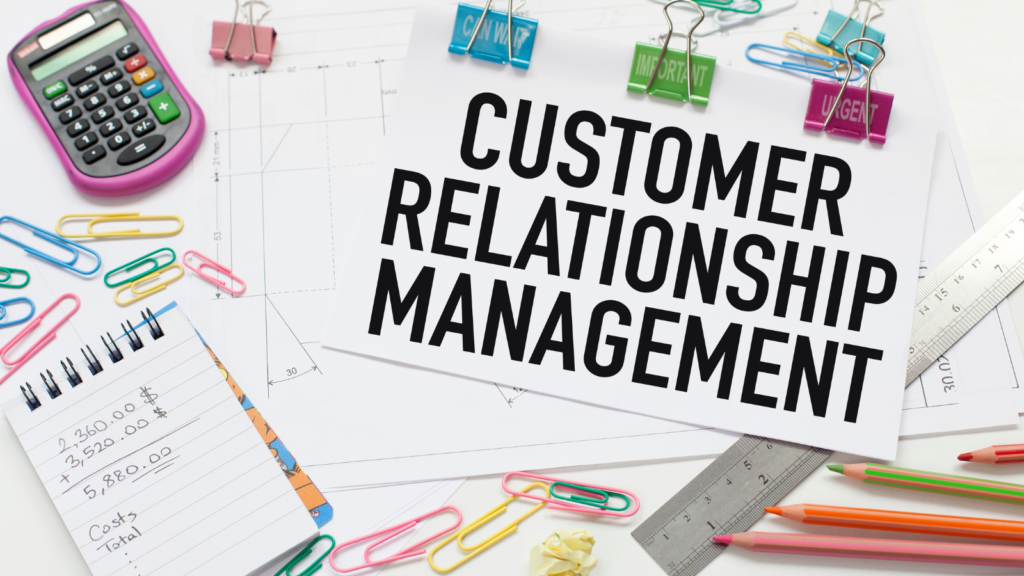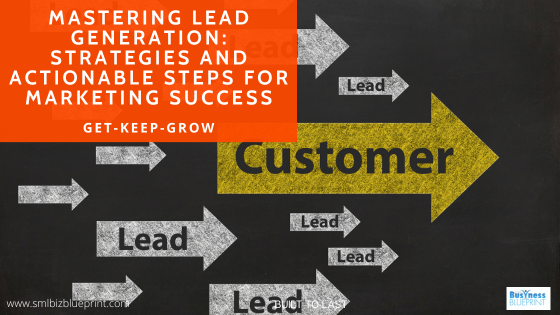In today’s competitive business landscape, generating high-quality leads is crucial for sustainable growth and success.
Marketers understand the importance of allocating a significant portion of their budget towards lead generation, with 53% investing at least half of their budget in this activity.
However, it’s essential to note that lead generation is the most expensive marketing endeavour.
To optimise your marketing efforts and achieve better results, it’s crucial to implement a well-designed lead generation system and focus on effective follow-up strategies.
In this blog post, we’ll delve into the key insights from an article about lead generation and discuss actionable steps to improve your lead generation efforts and drive consistent growth for your business.

1: The Two-Step Lead Generation System
The Two-Step Lead Generation System is one of the most effective lead generation strategies.
This system involves two integral components:
1 Direct Response Advertisements:
To attract attention and capture the interest of potential prospects, it’s essential to create direct response advertisements that offer attention-getting special reports.
These reports should provide valuable insights or solutions to your target audience’s common problems.
2 Contact Management System:
Once prospects show interest and respond to the advertisements, it’s crucial to have a robust contact management system in place for effective follow-up. This system allows you to nurture leads, build relationships, and guide prospects through the sales funnel.
Implementing this two-step lead generation system can significantly enhance your marketing efforts.
By carefully following this proven system, you can establish a continuous and never-ending stream of new prospects for your business.
Consistency and persistence are critical, as you need to continually attract, engage, and convert prospects to customers.
2 Doubling Marketing Results
Many businesses often overspend on acquiring new customers without considering more effective marketing strategies.
It’s crucial to assess your current marketing methods and make the necessary changes to optimise your marketing budget and achieve better results.
We suggest asking yourself the following questions:
- What marketing methods are you currently using to acquire new clients?
- How do these methods differ from when you started your business?
- How do they compare to the strategies used in your industry or profession 20 years ago?
- Do your advertising or direct mail campaigns consistently generate profits?
- Do you have an ongoing marketing system that delivers consistent, measurable, and predictable results?
- What response rates are you achieving, and are you satisfied with them?
Most business owners and salespeople stick to traditional marketing methods year after year, expecting different results.
It’s important to rethink and revamp your marketing strategies to break this cycle.
You can generate better outcomes while reducing costs by leveraging innovative approaches like direct response advertising and lead generation systems.
3: The Power of Direct Response Ads
Direct response advertising is a highly effective approach to engage prospects and generate leads. Unlike traditional image ads, direct response ads have distinct characteristics that make them unique and impactful.
Here are some key features of direct response ads highlighted in the article:
- Trackability:
Direct response ads allow you to track the exact ad and media that prospects respond to when they contact you for more information or to place an order. This tracking capability helps measure the effectiveness of different ads and informs necessary adjustments.
- Measurability:
Since you can determine which ads are generating responses and how many contacts you receive from each one, you can measure the performance of your ads accurately. This data lets you identify the most effective ads and make informed decisions about refining or discontinuing underperforming ones.
- Accountability:
Direct response ads hold you accountable for delivering results. By analysing response rates, conversion rates, and sales generated from these ads, you can evaluate their impact on your business’s bottom line.
- Immediate Feedback:
Direct response ads provide immediate feedback from prospects who respond, allowing you to gauge their level of interest and adjust your follow-up approach accordingly.
To create compelling direct-response ads, consider incorporating the following elements:
- Attention-Grabbing Headlines:
Craft headlines that immediately capture the reader’s attention and pique their curiosity. A compelling headline is the first step to engage prospects and entice them to read further. - Irresistible Offers:
Provide valuable and irresistible offers that resonate with your target audience. These offers should address their pain points and present tangible solutions or benefits. - Simple Response Methods:
Make it easy for prospects to respond to your offer by providing a simple and convenient method, such as a click-to-call button or an online form. - Time or Quality Limits:
Create a sense of urgency by placing time or quality limits on your offers. Limited-time promotions or exclusive deals can encourage prospects to take immediate action. - Tracking Codes:
Use unique tracking codes or identifiers in your ads to determine the response rate of each advertisement. This information helps assess the effectiveness of your campaigns and optimise future efforts.
By transforming your ads into direct response ads, you can convert them into powerful lead-generating tools. Direct response ads focus on eliciting a response from prospects and fostering a connection rather than merely aiming for name recognition.

4: Effective Follow-Up Strategies
Lead generation is only half the battle. You need to establish a systematic follow-up marketing process to maximise conversions and turn prospects into paying customers.
This section explores the importance of follow-up and offers insights into building an effective system.
- The Importance of Follow-Up:
Research shows that prospects often require repeated exposure to your marketing message before becoming paying clients. It can take up to seven exposures to convert a prospect into a customer. Establishing consistent follow-up helps nurture leads, build trust, and increase the likelihood of conversions.
- Automated Follow-Up:
To streamline your follow-up efforts and optimise your time, leverage automated options such as email marketing. Setting up a sequential autoresponder allows you to create a series of pre-programmed emails delivered at predetermined intervals.
This automated system ensures prospects receive regular communication and valuable information, guiding them towards purchasing decisions.
- The Ideal Follow-Up Sequence:
An effective follow-up marketing system should include a well-structured sequence of communications. Here’s an example of an ideal follow-up sequence:
- Day 1: Prospect sees your ad, clicks on it, and requests the free report. The report is immediately emailed to the prospect.
- Day 2: Follow-up email asking how they found the report and if they have any questions or concerns.
- Day 5: This is the second follow-up email reiterating the report’s highlights, addressing any additional questions or concerns, and offering the opportunity to schedule an appointment or phone discussion.
- Day 10: Another follow-up email providing additional information to assist the prospect in their decision-making process.
- Day 14 and beyond: Continue with periodic follow-up emails to maintain engagement and reinforce your value proposition.
Implementing a structured follow-up sequence increases the chances of converting leads into customers by staying top of mind and providing valuable insights throughout their decision-making journey.
5: Leveraging Lead Generation
To further emphasise the importance of lead generation and effective follow-up, let’s explore some compelling statistics related to these practices:
Marketing Automation:
80% of marketers believe that marketing automation generates more leads and conversions. By leveraging automation tools, you can streamline your lead generation and follow-up processes, saving time and increasing efficiency.
Timely Follow-Up:
Leads are nine times more likely to convert when businesses follow up within five minutes of initial contact. Quick and personalised responses demonstrate your commitment and increase the chances of converting leads into customers.
Nurtured Leads:
Companies that nurture leads generate 50% more sales at 33% lower costs. Implementing a consistent and well-structured follow-up system allows you to nurture leads over time, build relationships and increase the likelihood of conversion.
Lead Conversion Time:
Almost two-thirds of all leads aren’t sales-ready when initially acquired. On average, 63% of leads who inquire about your business won’t convert for at least three months. Patience and ongoing follow-up are essential to maximise conversion rates.
Lead Generation Outsourcing:
According to Fearless Competitor, outsourcing lead generation yields 43% better results than in-house lead generation. Consider partnering with a specialised agency to optimise your lead generation efforts and free up internal resources for other crucial marketing tasks.

Here’s a 10-step action plan for a business to implement the key points discussed in this article:
Step 1: Assess Your Current Lead Generation Methods:
Evaluate the marketing methods you are currently using to acquire new clients. Determine how they differ from your initial strategies and whether they are still effective in today’s market.
Step 2: Research Your Target Market:
Conduct in-depth research on your target market to understand their problems, pain points, and needs. This information will guide the creation of compelling direct-response ads and offers.
Step 3: Develop Attention-Grabbing Direct Response Ads:
Create direct-response advertisements that stand out and resonate with your target audience. Craft attention-grabbing headlines and make irresistible offers that address their pain points.
Step 4: Create Valuable Special Reports:
Design special reports or whitepapers that provide valuable insights or solutions related to your industry or products. Ensure they are educational, well-researched, and offer practical advice to your prospects.
Step 5: Implement Contact Management System:
Set up a contact management system to effectively capture and organise leads’ information. This system will help you manage and track follow-up interactions and ensure no leads fall through the cracks.
Step 6: Capture Leads with Opt-In Pages:
Create optimised opt-in pages where prospects can provide their contact information in exchange for your special reports. Make the process simple and appealing, ensuring a smooth lead capture experience.
Step 7: Set Up Automated Email Follow-Up:
Implement an automated email follow-up system using an email marketing tool or autoresponder. Create a sequence of emails that provide additional valuable content, address common concerns, and nurture leads over time.
Step 8: Monitor and Track Performance:
Monitor the performance of your ads, landing pages, and email campaigns regularly. Track response rates, conversion rates, and engagement metrics to identify areas for improvement and optimise your lead generation efforts.
Step 9: Refine and Optimize:
Based on the data and insights gathered, refine your ads, offers, and email sequences to enhance their effectiveness. Continuously test elements like headlines, offers, and email content to improve your lead generation and follow-up strategies.
Step 10: Continuously Evaluate and Scale:
Review your lead generation and follow-up processes regularly. Identify what’s working well and what needs improvement. As you succeed, scale your efforts by increasing your ad spend, expanding your target audience, or introducing new lead generation channels.
Following this 10-step action plan, you can implement the key points discussed in the article and establish a robust lead generation system with effective follow-up strategies. This systematic approach will help you attract high-quality leads, nurture relationships, and drive consistent business growth.
Conclusion
Mastering lead generation is vital for long-term marketing success. You can consistently attract and convert high-quality leads by implementing a two-step lead generation system, creating compelling direct response ads, and establishing an effective follow-up marketing process.
Remember to leverage automation tools, monitor and refine your strategies based on feedback, and always prioritise timely and personalised follow-up.
Lead generation is not a one-time effort but an ongoing process that requires dedication, adaptability, and a focus on building solid relationships with prospects. By effectively embracing smart marketing strategies and nurturing leads, you can unlock the potential for continuous growth and drive exceptional results for your business.
FAQs
Q1. What is lead generation, and why is it important for businesses?
A1 Lead generation refers to attracting and capturing potential customers’ interest in a product or service. It is crucial for businesses because it generates a pool of prospects to nurture and convert into paying customers, driving revenue growth and business success.
Q2. How can I assess if my current lead-generation methods are effective?
A2: You can assess the effectiveness of your lead generation methods by analysing key performance indicators such as conversion rates, lead quality, and return on investment (ROI). Evaluate the success of your campaigns based on these metrics to determine areas for improvement.
Q3. What are direct-response ads, and how do they differ from traditional advertising?
A3 Direct response ads are marketing messages designed to elicit an immediate response from the audience, such as clicking on a link or filling out a form. Unlike traditional advertising focusing on brand awareness, direct response ads aim to generate leads and drive conversions through targeted offers and calls to action.
Q4. How can I create compelling direct-response ads?
A4 To create compelling direct response ads, focus on crafting attention-grabbing headlines, making irresistible offers, and providing a simple method for the audience to respond. Use trackable elements to measure the ad’s effectiveness and refine your campaigns based on collected data.
Q5. What is an automated follow-up system, and why is it essential for lead generation?
A5 An automated follow-up system uses technology to send pre-programmed emails or messages to leads at predetermined intervals. It is important for lead generation because it allows businesses to nurture relationships with prospects, provide valuable information, and guide them through the sales funnel without manual intervention, increasing conversion rates and maximising ROI.
Other Reading
Unlock Business Growth: Essential Systems Every Small Business Owner Needs!
Boost Conversions: 12 Split Testing Best Practices for Small Biz!
7 Ways Improving Conversion Rates Will Redefine Your Business Growth

